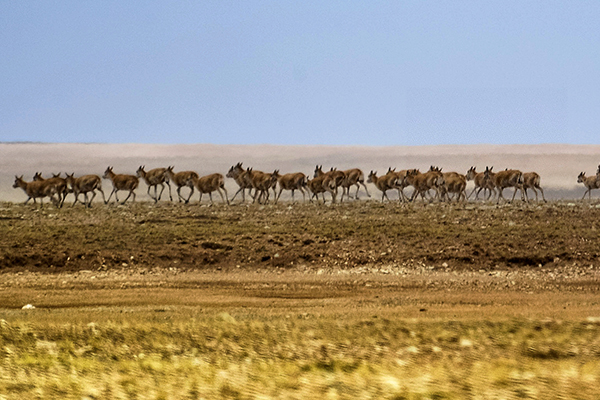
Tibetan antelopes migrate in June in Hoh Xil, one of the largest remaining natural habitats for wild animals in the world.[Photo/Xinhua]
The habitat of the Tibetan antelope in the Hoh Xil area of China’s Qinghai province will be nominated as a UNESCO World Natural Heritage site in 2017.
Xinhua News Agency quoted Jia Yingzhong, director of Qinghai’s Department of Housing and Urban-Rural Development, as saying preparation work on the application started at the end of 2014.
“In 2015, we will try to put Hoh Xil on China’s tentative list of world heritage sites, evaluate its natural resources and compile documents for the requisite reports,” Jia said.
Jia estimated that preparations would be completed in 2017 in time for a vote at the annual meeting of the World Heritage Committee.
China currently has 47 places on the World Hertiage list. If Hoh Xil is added, it would be a first for Qinghai province.
Hoh Xil, or Kekexili, lies in the border area of the Tibet autonomous region. It was designated in 1995 as a national nature preserve, covering 45,000 square kilometers and having an average elevation of 4,600 meters.
Hoh Xil means “beautiful girl” in the Mongolian language. It is China’s largest area of uninhabited land and has long been a paradise for wildlife. It’s home to more than 230 species of animals, 20 of which are under State protection, including the wild yak, Tibetan antelope, wild donkey, white-lip deer and brown bear.
In the latter part of the last century, poachers targeted the Tibetan antelope because of the popularity of the shahtoosh, a shawl made with the animal’s downy hair, in the United States and Europe. Antelope herds dwindled. Once numbering 200,000, the population dropped to only 20,000 by 1997.
A local official, Jesung Sonam Dargye, spent much of his life trying to save the Tibetan antelope, and a movie, Kekexili: Mountain Patrol, was based on his story.
“The sacrifice of Sonam Dargye helped to awaken the public’s awareness of the Hoh Xil ecosystem,” said Sonam Yangkyid, a delegate to the Qinghai People’s Congress. “Now the environment of Hoh Xil has improved a lot. The last will of Sonam Dargye has become reality.”
According to data provided by the Hoh Xil Nature Reserve Administration Bureau, no illegal hunting has been conducted since 2006, and the antelope population has rebounded to at least 60,000 in the area.
Zhu Chunquan, representing the International Union for Conservation of Nature China Office, said the case of the Tibetan antelope is an example of an important wildlife management success, and the experience acquired can be adopted in other areas for other endangered species.
“The first lesson is to tell the right story,” Zhu said. “Many consumers in the United States and Europe didn’t know their purchase would cause the death of the Tibetan antelope. With global publicity, demand has curbed dramatically.”
“Second is the engagement of the local government and local people,” Zhu said. “The central government began to pay attention when the local government and local people devoted a lot of energy to this.”
